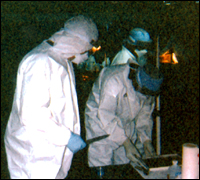WHEN DISASTER STRIKES
Fingerprint Team Always on Call
02/08/06
 |
| Members
of the Disaster Squad set up a makeshift
mortuary in St. Gabriel, Louisiana |
In the days and weeks after Hurricane Katrina ravaged the Gulf Coast the FBI did what comes natural to first responders-we went to the heart of the stricken area. Early on, agents aided a debilitated police force in New Orleans. Soon after, agents and analysts teamed with local authorities in the region to stem the swelling tide of scams preying on storm victims.
Throughout
the ordeal, as floodwaters receded and
the death toll rose, the FBI's Disaster Squad-a team of highly trained forensic examiners from the FBI Laboratory in Quantico, Virginia-performed the grim task of identifying the bodies left in Katrina's
wake.
In
the two months following Katrina, members
of the Disaster Squad examined 816 victims.
With help from personnel from the Criminal
Justice Information Services (CJIS) Division's
Fly Away Identification Team (FAIT) and
the Louisiana State Police, 155 bodies
were positively identified through fingerprints.
Efforts to identify the remaining victims
are continuing at the FBI Laboratory, where
experts in the Latent Print Operations
and Support Units try to link victims' prints
with known fingerprints culled by other
federal, state, and local agencies.
The
Disaster Squad’s role dates
back 65 years to the summer of 1940, when
a plane crash in Virginia—and the
ensuing logistical confusion—revealed
the need for a team of experts who could
travel to disaster scenes anywhere in the
world to coordinate recovery efforts with
local officials. Past cases include the
Oklahoma City bombing, the space shuttle
explosions, the USS Cole bombing
in Yemen, the 9/11 attacks, and tsunami
recovery efforts last year in Thailand,
where they coordinated with victim identification
teams from 31 countries to help identify
8,000 victims there.
After Katrina hit, the Disaster Squad was
deployed to Baton Rouge, along with personnel
from the Fly Away Team, which scans and digitizes
fingerprints and provides remote access to
the FBI’s database of more than 48
million fingerprints. On the ground, the
Disaster Squad coordinated with DEA fingerprint
specialists and the Louisiana State Police
Crime Laboratory. Squad members stayed in
makeshift quarters—abandoned World
War II-era barracks, camper trailers offered
by local church parishioners, and an apartment
donated by a local couple who wanted to help
with relief efforts.
A makeshift
mortuary was established in nearby St.
Gabriel, Louisiana, where the squad worked
rotating shifts for eight weeks to obtain
identifiable fingerprints from bodies badly
affected by the extreme heat and floodwaters.
Once retrieved, the prints were given to
CJIS fingerprint experts, who scanned and
searched them against prints on file at
their fingerprint facility in West Virginia.
Copies of the prints were also searched
against Louisiana's own fingerprint database, which contains some prints not on file with the FBI and led to several positive IDs.
To date, not including 9/11 and the tsunami in 2004, the Disaster Squad has assisted in 230 disasters involving 10,687 victims. It has positively identified 6,809 victims (64 percent) by fingerprints, palm prints, or footprints.
Working on disasters, though, is only a small part of their duties. The squad's 49 members-each having trained for nearly two years in fingerprint science to meet the select team's requirements-are kept busy analyzing latent (hidden) prints submitted by law enforcement agencies across the country and training our federal, state, and local partners on latent print collection.
Links: Katrina
Coverage | FBI
Laboratory | Criminal
Justice Information Services


